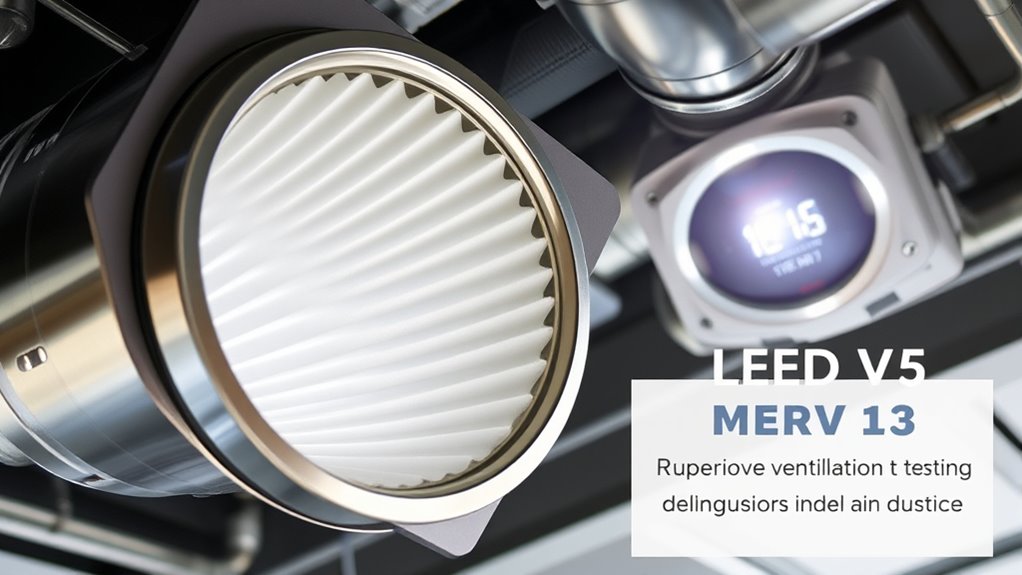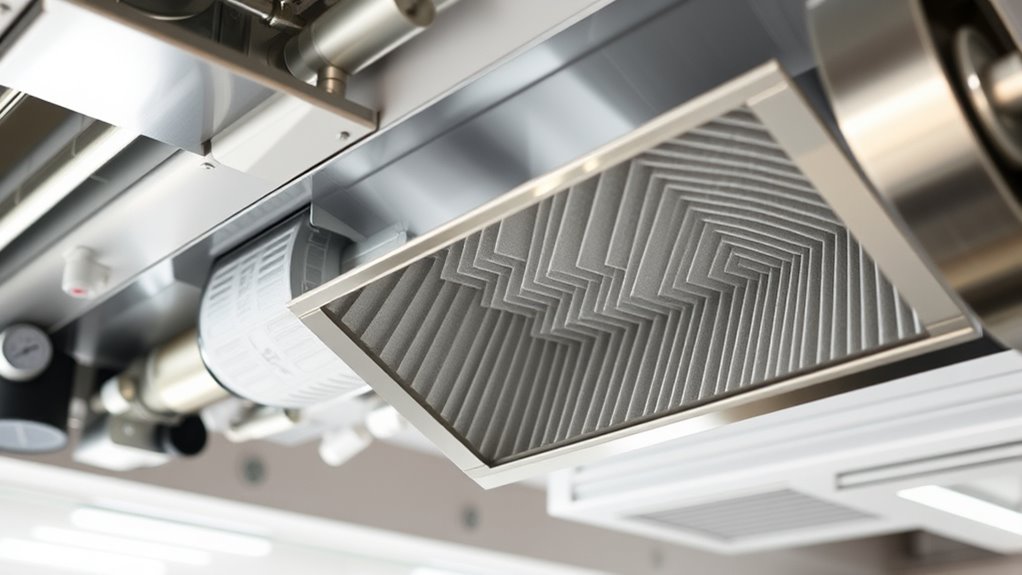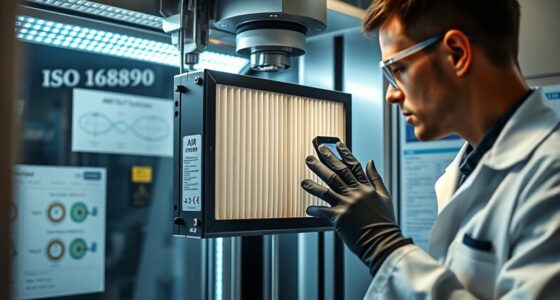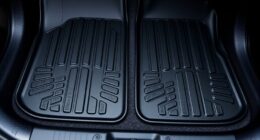LEED V5 requires you to use MERV 13 filters or higher to effectively capture airborne particles like dust, pollen, and microbes, improving indoor air quality. You also need to optimize your ventilation system by designing, installing, and maintaining efficient airflow that adjusts to occupancy levels, often through demand-controlled strategies. Thorough testing and verification confirm your HVAC systems operate correctly before occupancy, confirming compliance. Keep exploring to understand how these standards work together for healthier indoor environments.
Key Takeaways
- LEED V5 mandates the use of MERV 13 or higher filters to effectively capture airborne pollutants.
- It emphasizes optimizing ventilation systems for consistent airflow, pollutant removal, and energy efficiency.
- Demand-controlled ventilation strategies adapt outdoor air intake based on occupancy levels to improve indoor air quality.
- Thorough testing and commissioning of HVAC systems ensure airflow rates, filter efficiency, and indoor air quality standards are met.
- Ongoing verification and quality assurance confirm that filtration and ventilation strategies maintain a safe, healthy indoor environment.

Are you wondering how LEED V5 enhances indoor air quality standards? The answer lies in its focus on indoor pollutant control and ventilation efficiency. LEED V5 emphasizes creating healthier indoor environments by setting rigorous requirements for filtration, airflow, and testing procedures. When it comes to indoor pollutant control, the standard mandates the use of MERV 13 filters or higher. These filters are highly effective at capturing airborne particles, including dust, pollen, pet dander, and even some bacteria and viruses, considerably reducing indoor pollutants that can compromise occupant health. By ensuring high-quality filtration, LEED V5 helps minimize the presence of contaminants that can cause respiratory issues or allergic reactions, promoting a safer and more comfortable indoor environment. Additionally, advancements in automation can aid in maintaining optimal ventilation performance and system monitoring.
Ventilation efficiency is another core component of LEED V5’s approach to air quality. The standard requires buildings to optimize their ventilation systems to supply fresh air effectively while controlling energy consumption. This means that ventilation systems should be designed, installed, and maintained to operate at peak performance, ensuring consistent airflow and pollutant removal. Proper ventilation not only dilutes indoor pollutants but also prevents their accumulation, which is vital for maintaining healthy indoor air quality. LEED V5 encourages advanced strategies such as demand-controlled ventilation, which adjusts airflow based on occupancy levels, and the use of outdoor air during peak times to maximize fresh air intake without wasting energy. These measures directly contribute to better indoor air quality by reducing the concentration of pollutants and improving overall ventilation performance.
Testing is a key step in ensuring these standards are met. LEED V5 requires thorough testing and commissioning of HVAC systems to verify that filtration and ventilation strategies work as intended. This process involves measuring airflow rates, verifying filter efficiency, and evaluating indoor air quality through air sampling. By conducting these tests, building owners and operators can identify and correct any issues before occupancy, ensuring the system functions at its best. This proactive approach not only guarantees compliance but also assures occupants that the indoor environment is safe and healthy.
Frequently Asked Questions
How Often Should MERV 13 Filters Be Replaced for LEED Compliance?
You should replace MERV 13 filters every 6 to 12 months to meet LEED compliance. Regular air filter maintenance ensures ideal indoor air quality and system efficiency. If your HVAC system has recent upgrades or operates in high-traffic areas, consider changing filters more frequently, around every 3 to 6 months. Monitoring filter condition and adhering to manufacturer recommendations help maintain compliance and indoor air standards effectively.
Are Portable Air Purifiers Acceptable Under LEED V5 Requirements?
Portable air purifiers are generally acceptable under LEED V5 requirements, but they’re not a substitute for proper ventilation and MERV 13 filtration. You can use them to improve indoor air quality, especially in areas where ventilation is limited. However, for LEED certification, you need to verify they meet specific standards and are used as a supplementary measure rather than the primary solution. Always document their use accordingly.
How Does LEED V5 Address Indoor Pollutant Sources?
Indoor pollutant sources are tackled head-on in LEED v5 through robust source control strategies and indoor pollutant mitigation. You’re encouraged to minimize emissions from materials, furnishings, and processes, markedly reducing indoor air contaminants. By implementing proper source management, you create healthier spaces. These strategies are essential for meeting indoor air quality goals, ensuring your building maintains a safe, fresh environment that’s less affected by indoor pollutant sources.
What Are the Testing Procedures for Verifying Ventilation Effectiveness?
You verify ventilation effectiveness through airflow measurement and air exchange testing. You assess whether the airflow rates meet design specifications by measuring supply and exhaust air volumes. Additionally, you perform air exchange tests to guarantee adequate air turnover, which helps identify stagnant zones. Regular testing confirms the ventilation system maintains proper indoor air quality, reducing pollutants and ensuring occupant comfort. You document these results to demonstrate compliance with LEED V5 standards.
Can Existing HVAC Systems Be Upgraded to Meet LEED V5 Standards?
You can definitely upgrade your existing HVAC system to meet LEED v5 standards. Investigate your current setup to see if it can accommodate MERV 13 filters and enhanced ventilation controls. HVAC upgrades are often feasible and improve indoor air quality markedly. You might need to install new filters, increase outdoor air intake, or add ventilation testing. These improvements help guarantee your system delivers cleaner air and aligns with LEED requirements.
Conclusion
By embracing LEED v5’s air quality requirements, including MERV 13 filters, enhanced ventilation, and rigorous testing, you’re not just improving indoor air—you’re safeguarding your environment against threats as formidable as an army of invisible pollutants. These standards elevate your space to a level of purity that’s nothing short of revolutionary, ensuring health and well-being for all inside. Implementing these measures transforms your building into a sanctuary, setting a new benchmark for sustainability and air quality excellence.







